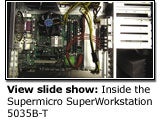VARs selling PCs usually have two paths to choose from: maximize margins and build a white box from scratch or reduce hassles and sell a name-brand system. While the arguments for which path is best could fill a book, there is yet another path, the road least traveled; start with a bare-bones system.
Bare-bones systems usually consist of a case, power supply and motherboard pre-assembled and tested. It becomes the VAR’s job to add a CPU, storage, memory, peripherals and an operating system. That allows a great degree of flexibility, yet still preserves quality.
Sure, building from a bare-bones system may seem a little more expensive than building a traditional white box, but the reduction in assembly time, initial component selection and improvement in quality should more than outweigh the few pennies saved by “a build-it-yourselfer.”
Founded in 1993, San Jose, Calif.-based Supermicro has built a significant presence in the market, thanks mostly to the channel. The company offers all of its systems either as bare-bones units or fully populated with hardware. That gives the vendor an edge when it comes to working with the channel. Solution providers can add value and increase margins by customizing systems with whatever hardware and software best suits the customer’s needs. What’s more, solution providers can choose “unbranded” versions of Supermicro’s systems, allowing the VAR to self brand PCs and servers.
One of the latest products from Supermicro is the SuperWorkstation 5035B-T, a high-performance, workstation-class system built in a mid-size tower configuration. Supermicro designs the case, motherboard and power supply to all work together and eschews third-party products for its bare-bones workstation.

Supermicro sent a 5035B-T over to eWEEK’s Channel Labs for us to put it through its paces and we were impressed with the quality and performance of the system. Most VARs will select the basic configuration of the 5035B-T, which comes as a bare-bones unit (case, motherboard and power supply). The system came with a Supermicro-branded super C2SBX Mainboard, a SC733TQ-465B mid-size tower case and a 465W AC power supply. Build quality of the bare-bones system was excellent, all screws were properly installed and tightened, all cables were routed cleanly and all LEDs/buttons worked properly.
The C2SBX motherboard offers a single LGA775 socket for a variety of Intel Core 2 processors. Solution providers will find a plethora of ports, four 240 pin DIMM sockets and an integrated Serial ATA (SATA) Raid Array. The motherboard uses the Intel X38 chipset and offers High Definition 7.1 audio. The 5035B-T should cost under $600; the price can vary based upon partner levels, quantities and distributor arrangements.
To build a working system from the bare-bones unit, we added an Intel Quad Core 2.33Ghz CPU, four Gbytes of DDR3 (1333mhz) RAM, a 120Gbyte Seagate SATA drive, a BenQ DVD RW optical drive and an NVidia Quadro FX5600 display adapter. The idea here was to build a high-performance system without breaking the bank. Windows Vista Business Edition was installed on the system for testing.
Assembly was straight forward, to access the internals, two thumb screws needed to be loosened on the side access panel, and the side panel popped right off. The internals were well laid out and all labeled. The case is spacious and offers ample room for add-on cards and good airflow for cooling.
The front of the case is hidden behind a lockable door; to access the hard drive bays just open the door and pop out a tray from the raid array to install a hard drive. The access door has a “pop-in” hinge arrangement, which allows the door to fall off the unit when open, although this seemed to be the only component that was of low quality on the case.
Performance was tested with Passmark Performance Test 6.1, the system offered a very good overall score of 1066.5. Although that was a relatively high score, it could not unseat eWEEK Channel Labs’ reigning champ, the SUN Ultra 24.
The Ultra 24 came in with an overall PassMark score of 1269, thanks mostly to an Intel Core 2 Extreme CPU (Q6850). Installing that processor into the Supermicro system would probably result in a higher score than the Sun Ultra 24. The advantage is that the Supermicro SuperWorkstation uses DDR3 RAM, while the Ultra 24 uses DDR2. The real kicker here is that the tested configuration of the Supermicro workstation would probably retail for a third of the price of the Ultra 24.
Power usage was measured using a “Kill-a-Watt Pro” and the unit peaked at 231 watts under the maximum load of the PassMark test suite. In an idle state, the system was measured at 174 watts.
Supermicro offers a three-tier channel program, with authorized, value-added and gold levels; each carry different sales requirements. The partner program is free to join, and offers a variety of training options. No-charge tech support is free for partners and end users. Other benefits include demo units, rebates, spiffs and MDF.
